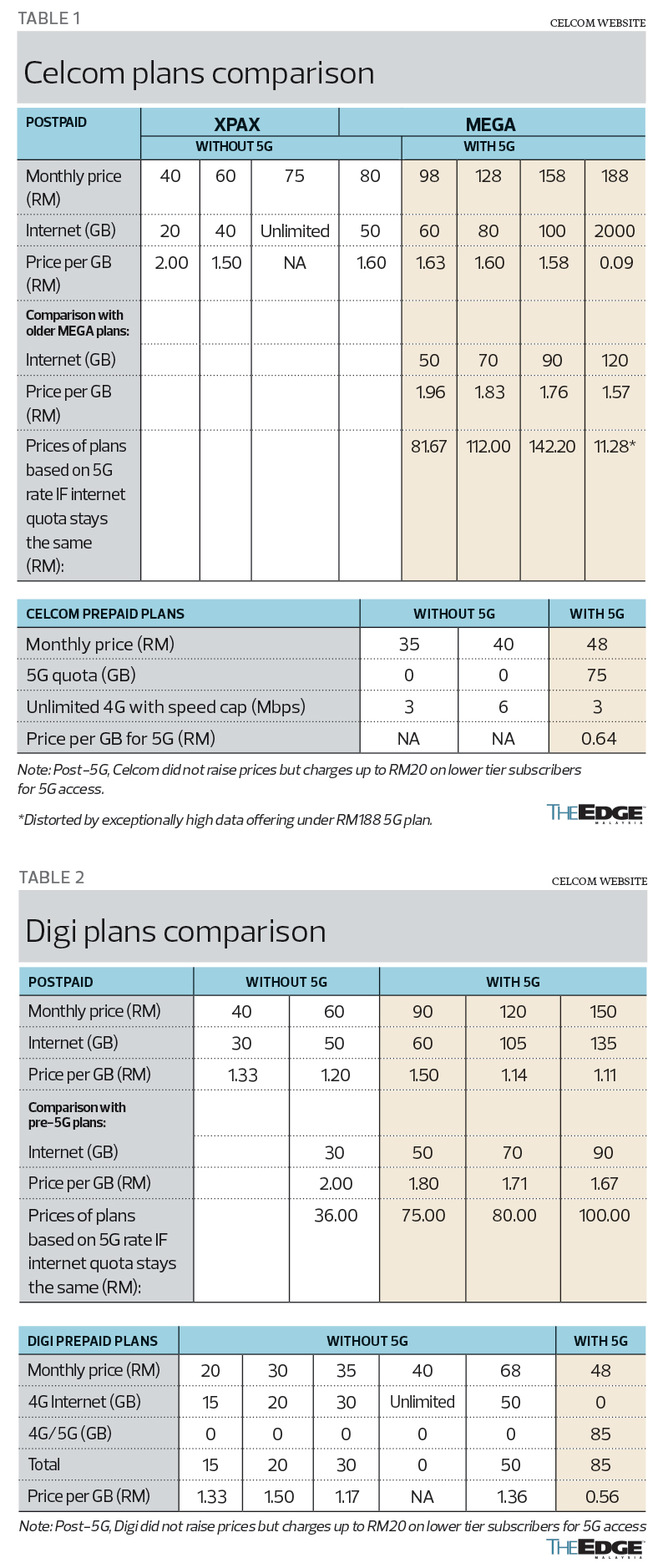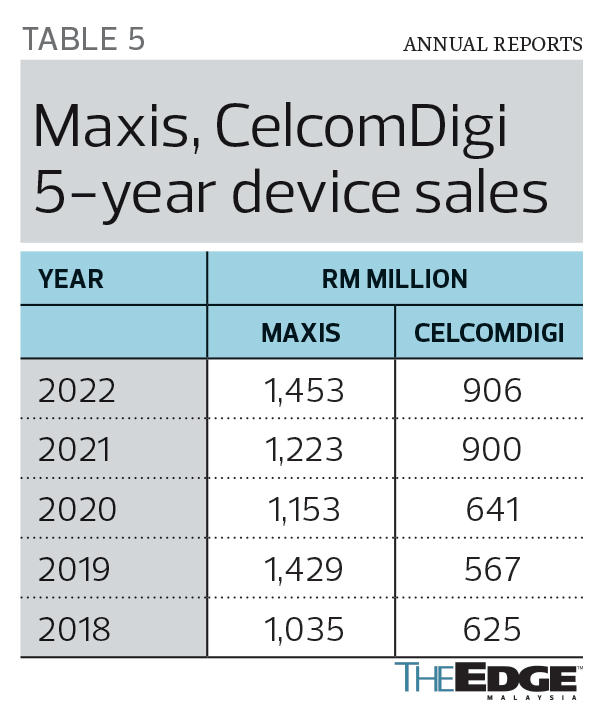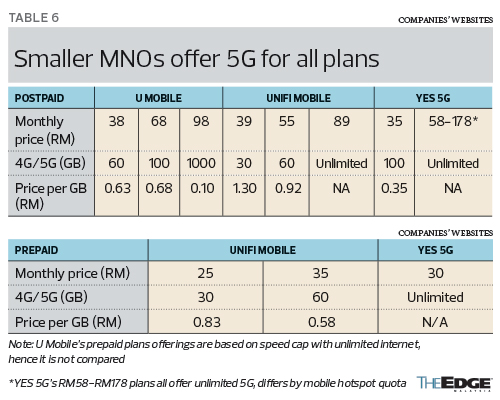
MNOs attracted higher subscriptions from device-bundled plans last year. (Photo by Patrick Goh/The Edge)
This article first appeared in The Edge Malaysia Weekly on August 28, 2023 - September 3, 2023
WHEN Myra Mahyuddin hesitated to upgrade her cellular service to 5G, she was not the only one. Like many other phone users, the wife of Minister of Communications and Digital Fahmi Fadzil was deterred by the additional fee required to connect to the next generation of high-speed wireless internet.
Many in the country were expecting the advent of 5G to not only replace the notoriously poor quality of 4G internet, but also take some pressure off their monthly expenses amid the elevated cost of living.
But now, Myra’s predicament has prompted Fahmi to arrange a meeting with the CEOs of local mobile network operators (MNOs), the Lembah Pantai lawmaker told reporters last Tuesday (Aug 22).
As the public and Myra await the outcome of the meeting with bated breath, The Edge takes a look at the various MNOs’ mobile plan offerings to find out why Malaysians have to pay more to access 5G.
Upon the latest review of mobile plans by MNOs after 5G was made available, the three biggest brands in Malaysia — Maxis, Celcom and Digi — expect their existing subscribers to pay up to RM20 more per month to enjoy 5G.
While Maxis’ surcharge of about RM10 is imposed on all existing subscribers, Celcom and Digi’s surcharges vary depending on the mobile plan: basically, higher-tier subscribers have access for free while lower-tier subscribers have to pay up to RM20 more.
It is worth noting that with the additional fee, subscribers are entitled to higher monthly internet usage, bringing down the price per Gigabyte (GB).
Comparisons of available mobile plans today and those prior to 5G availability show that the price per GB declines noticeably once the newer network is included, regardless of whether it is postpaid or prepaid (see Tables 1, 2,4 and 7), reflecting the benefits of shared infrastructure and spectrum among MNOs under the Single Wholesale Network (SWN) model managed by Digital Nasional Bhd (DNB).
Furthermore, the 5G rollout model has enabled smaller players like U Mobile, Unifi Mobile and YES 5G to offer 5G networks at more competitive rates (see Table 6), levelling the industry’s playing field.
This compares to the 4G era, when spectrum owners built their own network infrastructure for their own use and leased out some capacity to mobile virtual network operators.
For the rollout of 5G, DNB acts as an independent wholesaler and spectrum owner — building the required infrastructure and leasing its capacity to all MNOs, avoiding duplicated investment and, thus, lowering the capital expenditure required for the industry, the wholesale access price and, theoretically, retail prices as well.
However, instead of lowering the monthly bill for consumers to access the faster 5G, the bigger MNOs now appear to have done otherwise by telling subscribers to pay, say, just RM10 extra in return for more data than most of them actually use, which means a higher monthly bill, as experienced by the minister’s wife.
To use an analogy, a popular bakery introduces premium cheesecake at RM10 per slice, cheaper than the RM20 for regular cheesecake. However, in order to enjoy the premium cake, customers have to buy three slices for RM30, at least. The price per slice of premium cheesecake (like the price per gigabyte of data) may be lower than the regular one, but customers still have to pay more for it as they have to buy three slices, instead of just the one piece that they need. Furthermore, the bakery is not lowering the price of regular cheesecake. Someone who wants just one piece of cake will have to pay either RM20 for the regular cheesecake or RM30 for three slices of premium cake.
Why make consumers pay for what they don’t need?
Take Maxis (see Table 4). Before it agreed to sign the access agreement with DNB to enable it to provide 5G services to its customers, its RM98 monthly postpaid phone plan offered 60GB of 4G internet quota, translating into about RM1.63 per GB.
After signing up, the MNO has increased the price of its postpaid plans by RM11. This brings the RM98 monthly plan to RM109 today, but with a significantly higher internet usage of 150GB in total — 100GB interchangeably between 4G and 5G networks and 50GB of pure 5G network — translating into 73 sen per GB, from RM1.63 previously.
However, customers may not necessarily require that much data, according to Maxis CEO Goh Seow Eng in the group’s 2022 annual report. Mobile customers used an average of 26.6GB per month as at end of last year, a 77% increase in mobile data usage since 2019.
Even if such consumption doubled to 53.2GB three years from now, it is still much lower than the 120GB internet quota that Maxis’ cheapest postpaid plan offers currently. Under Maxis’ affordable brand Hotlink, its cheapest 5G mobile plan that costs RM70 a month offers up to 105GB (see Table 7).
Had Maxis maintained the internet quota of 60GB but priced its plans according to the lower 5G rate of 73 sen, the same subscriber for the RM98 plan would be paying just RM43.60 today, instead of an additional RM11 every month to access 5G (see Table 4).
A similar measure has also been adopted by Celcom and Digi in their postpaid plans, where instead of lowering the prices of their phone plans by taking advantage of the lower wholesale access pricing, the MNOs opted to offer a higher internet usage while maintaining the monthly fee.
According to CelcomDigi Bhd’s latest annual report, average monthly data usage by Digi customers was 24.5GB each last year, an increase of 18.4%; while for Celcom users, it was 27.9GB each, up 15.1%.
Contracted customers may have little choice
Although Putrajaya aspires to make 5G ubiquitous in Malaysia and at the fastest rate to catch up with regional peers, high prices imposed by the three largest MNOs by subscriber base may deter its adoption. This is especially so for customers who had signed up for a contract without 5G access.
Maxis’ Goh says in the annual report that the company managed to attract higher subscriptions from device-bundled plans, increasing its device revenue by 18.8% to more than RM1.4 billion last year before the group signed the access agreement with DNB (see Table 5).
In comparison, CelcomDigi saw a smaller growth of 0.7% in device revenue to RM907 million last year.
Maxis’ subscribers who have signed up for a multi-year contract would have to pay an extra RM10 to gain access to 5G, while Celcom and Digi only require lower-tier customers to pay up to RM20, giving premium users free access.
Contracted customers are also not allowed to downgrade their existing plans, or they will be subject to a one-time penalty fee for early termination.
To be fair, as commercial entities, the Big Three MNOs are not doing anything wrong in delivering the best shareholders’ interest, especially when industry margin has been under pressure in recent years amid competition in a saturated market like Malaysia’s.
Fahmi revealed that MNOs are slated to announce a series of 5G Rahmah Packages on Aug 31.
Perhaps by then, Myra, and those eager to improve their current network quality and not bound by any contract, will be able to get 5G services at a more affordable price.
Save by subscribing to us for your print and/or digital copy.
P/S: The Edge is also available on Apple's App Store and Android's Google Play.
- Trump says he is reluctant to keep raising tariffs on China
- US stock rebound fizzles as Trump goes on offensive
- Court orders preacher to pay RM2.5 mil to KJ for defamatory statements on Covid-19 vaccination
- Trump moves to levy Chinese vessels in widening trade war
- Chinese tea chain’s US shares rise 43% as IPO defies volatility
- Ban on single-use plastic bags in parks and certain premises
- Archidex 2025 to debut World of Works' immersive workspace showcase in Asean
- Tariffs to trigger sharp US economic slowdown, chance of recession now at 45% — Reuters poll
- Malaysia's economic growth likely slowed in 1Q, official flash estimates show
- Pimco bearish on dollar, long-term Treasuries as US safe-haven status wavers





